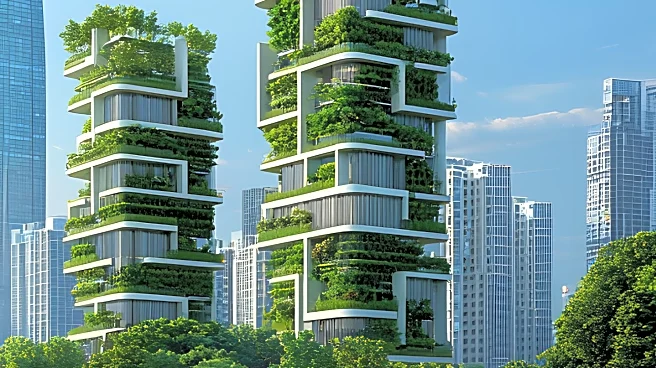What's Happening?
Vertical gardens, also known as living walls or green walls, are being increasingly adopted in urban areas to address the lack of green spaces. These gardens are installed on vertical surfaces such as office
buildings, apartment complexes, and shopping centers. They offer a sustainable solution to incorporate greenery in densely populated areas. Vertical gardens not only enhance the aesthetic appeal of urban environments but also provide several environmental benefits. They improve air quality by absorbing pollutants and converting carbon dioxide into oxygen. Additionally, they help mitigate the urban heat island effect, support biodiversity by providing habitats for various species, and reduce noise pollution by acting as natural sound barriers.
Why It's Important?
The adoption of vertical gardens in urban areas is significant due to their potential to improve environmental conditions and enhance the quality of life for city dwellers. By increasing green spaces, vertical gardens contribute to better air quality and reduced urban temperatures, which are critical in combating climate change and improving public health. They also promote biodiversity by providing habitats for insects and birds, which is essential for maintaining ecological balance. Furthermore, vertical gardens can enhance the aesthetic appeal of urban areas, making them more attractive and livable. This can lead to increased property values and improved mental well-being for residents.
What's Next?
As the demand for green spaces in urban areas continues to grow, the implementation of vertical gardens is likely to increase. Cities may adopt policies to encourage or mandate the installation of vertical gardens on new and existing buildings. This could involve incentives for developers and property owners to incorporate green walls into their designs. Additionally, advancements in technology and materials may lead to more efficient and cost-effective vertical garden systems, making them accessible to a wider range of urban environments. The continued research and development in this field could also result in innovative solutions for integrating vertical gardens into urban infrastructure.
Beyond the Headlines
Vertical gardens have the potential to transform urban landscapes by integrating nature into the built environment. This integration can lead to a cultural shift towards more sustainable and eco-friendly urban living. As people become more aware of the benefits of green spaces, there may be increased public support for policies that promote urban greening initiatives. Moreover, vertical gardens can serve as educational tools, raising awareness about environmental issues and the importance of biodiversity. They can also inspire community engagement and collaboration in creating greener, healthier cities.











